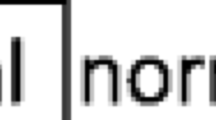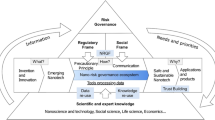Abstract
Risk management of nanotechnology is challenged by the enormous uncertainties about the risks, benefits, properties, and future direction of nanotechnology applications. Because of these uncertainties, traditional risk management principles such as acceptable risk, cost–benefit analysis, and feasibility are unworkable, as is the newest risk management principle, the precautionary principle. Yet, simply waiting for these uncertainties to be resolved before undertaking risk management efforts would not be prudent, in part because of the growing public concerns about nanotechnology driven by risk perception heuristics such as affect and availability. A more reflexive, incremental, and cooperative risk management approach is required, which not only will help manage emerging risks from nanotechnology applications, but will also create a new risk management model for managing future emerging technologies.



Similar content being viewed by others
References
Abbot KW, Marchard GE, Sylvester DJ (2006). A framework convention for nanotechnology? Environmental Law Reporter 36:10931–10942
Ackerman BA, Stewart RB (1985) Reforming environmental law. Stanford Law Rev 37:1333–1365
Austin C. Study shows Americans encouraged by prospects of nanotechnology (July 14, 2004). http://www.ncsu.edu/news/press_releases/04_07/211.htm. Cited May 4, 2007
Ayres I, Braithwaite J (1992) Responsive regulation: transcending the deregulation debate. New York, Oxford University Press
Babich A (2003) Too much science in environmental law. Columbia J Environ Law 28:119–184
Baram MS (1984) Alternatives to regulation: managing risks to health, safety, and the environment. Lexington Books, Lexington, MA
Breggin LK, Carothers L (2006) Governing uncertainty: the nanotechnology environmental, health, and safety challenge. Columbia J Environ Law 31:285–329
Bowman DM, Hodge GA (2007) A small matter of regulation: an international review of nanotechnology regulations. Columbia Science and Technology Law Review, 8:1–36
Bowman DM, Hodge GA (2006) Nanotechnology: mapping the wild regulatory frontier. Futures 38:1060–1073
Braithwaite V, Levi M (eds) (1998) Trust and governance. New York: Russell Sage
Colvin VL (2003) The potential environmental impact of engineered nanomaterials. Nat Biotechnol 21:1166–1170
Cross FB (1996) Paradoxical perils of the precautionary principle. Wash Lee Law Rev 53:851–925
Drexler E (1986) Engines of creation. Anchor, New York
Driesen DD (2005) Distributing the costs of environmental, health, and safety protection: the feasibility principle, cost-benefit analysis, and regulatory reform. Environ Aff 32:1–95
Environmental Defense, American Chemistry Council (2005) Joint statement of principles. Available at www.environmentaldefense.org/documents/4857_ACC-ED_nanotech.pdf
Environmental Defense, DuPont (2007) Nano risk framework. Available at www.nanoriskframework.com
ETC Group (2003) The big down: Atomtech—technologies converging at the nano-scale. http://www.etcgroup.org/upload/publication/171/01/thebigdown.pdf. Cited Sept. 29, 2007
Fiedler F, Reynolds G (1994) Legal problems of nanotechnology: an overview. S Cal Interdisc LJ 3:593–629
Florini K, Walsh S, Balbus JM, Denison R (2006) Nanotechnology: getting it right the first time. Nanotechnol Law Bus 3:39–53
Forrest D (1989) Regulating nanotechnology development, Foresight Nanotech Institute, March 23, 1989. http://www.foresight.org/nano/Forrest1989.html. Cited September 29, 2007
Friends of the Earth (Australia) (2007). Who’s afraid of the precautionary principle? http://nano.foe.org.au/node/186. Cited Sept. 29, 2007
Greenwood M (2007) Thinking big about things small: creating an effective oversight system for nanotechnology. Woodrow Wilson International Center for Scholars, Washington, DC
Gregory R, Flynn J, Slovic P (1995) Technological stigma. American Scientist 83:220–223
Gwinn MR, Vallyathan V (2006) Nanoparticles: health effects—pros and cons. Environ Health Perspect 114:1818–1825
Holm S, Harris J (1999) Precautionary principle stifles discovery (letter). Nature 400:398
International Risk Governance Council (IRGC) (2006). White paper on nanotechnology risk governance (Geneva, IRGC). http://www.irgc.org/irgc/_b/contentFiles/IRGC_white_paper_2_PDF_final_version.pdf. Cited September 29, 2007
International Center for Technology Assessment (ICTA) et al. (2007) Principles for the oversight of nanotechnologies and nanomaterials. http://www.icta.org/doc/Principles%20for%20the%20Oversight%20of%20Nanotechnologies%20and%20Nanomaterials_final.pdf. Cited Sept. 29, 2007
Johnson BB (1993) Advancing understanding of knowledge’s role in lay risk perception. Risk Issues Health Saf 4:189–212
Joy B (2000) Why the future doesn’t need us. Wired, August 4, 2000. http://www.wired.com/wired/archive/8.04/joy_pr.html. Cited Sept. 29, 2007
Jukes TH (1986) Frost resistance and Pseudomonas. Nature 319:617
Kahan D, Slovic P, Braman D, Gastil J, Cohen GL (2007) Affect, values, and nanotechnology risk perceptions: an experimental investigation. http://papers.ssrn.com/sol3/papers.cfm?abstract_id=968652. Cited May 3, 2007
Kahneman D, Slovic P, Tversky A (eds) (1985) Judgement under uncertainty: heuristics and biases. Cambridge University Press, Cambridge
Kasperson JX et al (2003) The social amplification of risk: fifteen years of research and theory. In: Pidgeon N, Kasperson RE, Slovic P (eds) The social amplification of risk. Cambridge University Press, Cambridge
Kolata G (2001) Scientists debate what to do when findings aid an enemy. New York Times Sept. 25, 2001:D1
Kuran T, Sunstein CR (1999) Availability cascades and risk regulation. Stanford Law Rev 51:683–768
Kuzma J (2007) Moving forward responsibly: oversight for the nanotechnology–biology interface. J Nanopart Res 9:165–182
Lin AC (2007) Size matters: regulating nanotechnology. Harvard Environ Law Rev 31:349
Lin-Easton PC (2001) It’s time for environmentalists to think small—real small: a call for the involvement of environmental lawyers in developing precautionary policies for molecular nanotechnology. Georget Int Environ Law Rev 14:106–134
Mandel G (2005) Technology wars: the failure of democratic discourse. Mich Telecommun Law Rev 11:117–190
Marchant GE (2003) From general policy to legal rule: the aspirations and limitations of the precautionary principle. Environ Health Perspect 111:1799–1803
Marchant GE, Mossman KL (2004) Arbitrary and capricious: the precautionary principle in the European Union courts. AEI, Washington, DC
Marchant GE, Sylvester D (2006) Transnational models for regulation of nanotechnology. J Law Med Ethics 34:714–725
Maynard AD (2006a) Nanotechnology: a research strategy for addressing risk. Woodrow Wilson International Center for Scholars, Washington, DC
Maynard AD (2006b) Safe handling of nanotechnology. Nature 444:267–269
McCubbin PR (2005) The risk in technology-based standards. Duke Environ Law Policy Forum 16:1–56
Morrissey SR (2007) Understanding nanotechnology. Chemical & Engineering News April 16, 2007:35–37
Nel A, Xia T, Maedler L, Li N (2006) Toxic potential of materials at the nanolevel. Science 311:622–627
Oberdörster G et al (2005) Principles for characterizing the potential human health effects from exposure to nanomaterials: elements of a screening strategy. Particle & Fibre Toxicology 2:8
Paddock L (2006) Keeping pace with nanotechnology: a proposal for a new approach to environmental accountability. Environ Law Report 36:10943–10952
Peter D. Hart Research Associates, Inc. (2006) Report findings. http://www.nanotechproject.org/file_download/98. Cited May 4, 2007
Phoenix C, Drexler E (2004) Safe exponential manufacturing. Nanotechnology 15:869–872
Pidgeon N, Kasperson RE, Slovic P (eds) (2003) The social amplification of risk. Cambridge University Press, Cambridge
Posner R (2004) Catastrophe. Oxford, University Press
Rachlinski J (2003) The uncertain psychological case for paternalism. Northwest Univ Law Rev 97:1165–1225
Rajeski D (2004) The next small thing. The Environmental Forum, March/April, pp. 42–49
Renn O, Roco MC (2006) Nanotechnology and the need for risk governance. J Nanopart Res 8:153–191
Reynolds GH (2003) Nanotechnology and regulatory policy: three futures. Harv J Law Technol 17:179–209
Sandin P (1999) Dimensions of the precautionary principle. Hum Ecol Risk Assess 5:889–907
Scientific Committee on Emerging and Newly Identified Health Risks (SCENIHR), European Commission (2007) Opinion on the appropriateness of the risk assessment methodology in accordance with the technical guidance documents for new and existing substances for assessing the risks of nanomaterials. http://ec.europa.eu/health/ph_risk/committees/04_scenihr/docs/scenihr_o_004c.pdf. Cited Sept. 29, 2007
Segal S (2004) Environmental regulation of nanotechnology: avoiding big mistakes for small machines. Nanotechnol Law Bus 1:290–303
Shapiro SA, McGarity TO (1991) Not so paradoxical: the rationale for technology-based regulation. Duke Law J 1991:729–752
Sheetz T et al (2005) Nanotechnology: awareness and societal concerns. Technol Soc 27:329–345
Slovic P (2000) The perception of risk. London, Earthscan
Slovic P (2004) What’s fear got to do with it? It’s affect we need to worry about. Miss Law Rev 69:971–990
Slovic P, Peters E, Finucane ML, MacGregor DG (2005) Affect, risk, and decisionmaking. Health Psychol 24:S35–40
Sunstein CR (1991) Administrative substance. Duke Law J 1991:607–646
Sunstein CR (2002a) The laws of fear. Harvard Law Rev 115:1119–1168
Sunstein CR (2002b) Probability neglect: emotions, worst-cases, and law. Yale Law J 112:61–108
Sunstein CR (2003a) Beyond the precautionary principle. Univ PA Law Rev 151:1003–1058
Sunstein CR (2003b) Hazardous heuristics. Univ Chicago Law Rev 70:751–781
Sunstein CR (2004) Precautions against what? The availability heuristic and cross-cultural risk perception. Alabama Law Rev 57:75–101
Sunstein CR (2006) Irreversible and catastrophic. Cornell Law Rev 91:841–897
Sweet L, Strohm B (2006) Nanotechnology—life-cycle risk management. Hum Ecol Risk Assess 12:528–551
Sylvester D, Lohr S (2005) Counting on confidentiality: legal and statistical approaches to federal privacy law after the USA Patriot Act. Wisconsin Law Rev 2005:1036–1138
Thayer AM (2006) Chance of a lifetime. Chem Eng News 1:10–18
Tversky A, Kahneman D (1982) Judgment under uncertainty: heuristics and biases. In Kahneman et al. (eds) Judgment under uncertainty: heuristics and biases, pp 3–19
U.S. Environmental Protection Agency (EPA) (2007) Science Policy Council, Nanotechnology White Paper, EPA 100/B-07/001. http://es.epa.gov/ncer/nano/publications/whitepaper12022005.pdf. Cited Sept. 29, 2007
Wagner WE (2000) The triumph of technology-based standards. Univ Ill Law Rev 2000:83–113
Weckert J, Moor J (2006) The precautionary principle in nanotechnology. Int J Appl Philos 20:191–204
Wejnert J (2004) Regulatory mechanisms for molecular nanotechnology. Jurimetrics J 44:323–350
Wexler L (2006) Limiting the precautionary principle: weapons regulation in the face of scientific uncertainty. U.C. Davis Law Rev 39:459–527
Wiedemann PM, Schutz H (2005) The precautionary principle and risk perception: experimental studies in the EMF area. Environ Health Perspect 113:402–405
Wilson RF (2006) Nanotechnology: the challenge of regulating known unknowns. J Law Med Ethics 34:704–713
Author information
Authors and Affiliations
Corresponding author
Rights and permissions
About this article
Cite this article
Marchant, G.E., Sylvester, D.J. & Abbott, K.W. Risk Management Principles for Nanotechnology. Nanoethics 2, 43–60 (2008). https://doi.org/10.1007/s11569-008-0028-9
Received:
Accepted:
Published:
Issue Date:
DOI: https://doi.org/10.1007/s11569-008-0028-9




